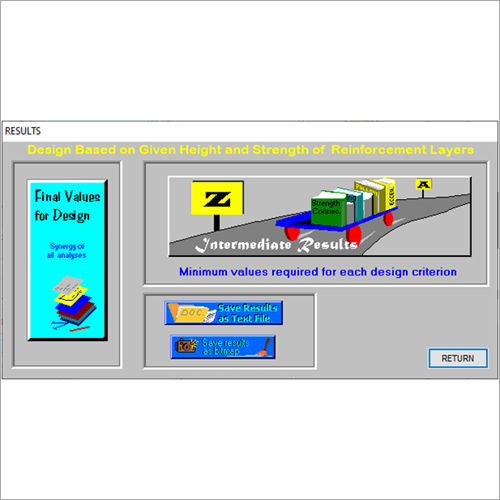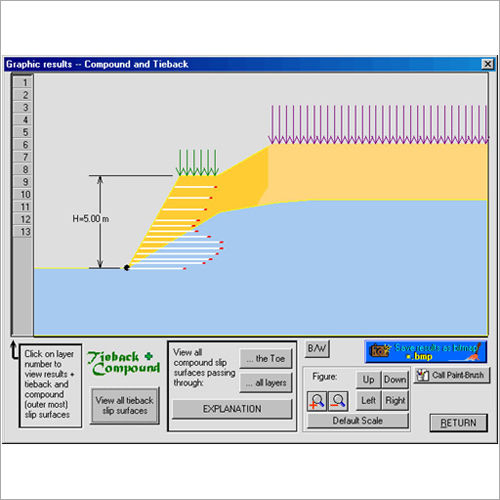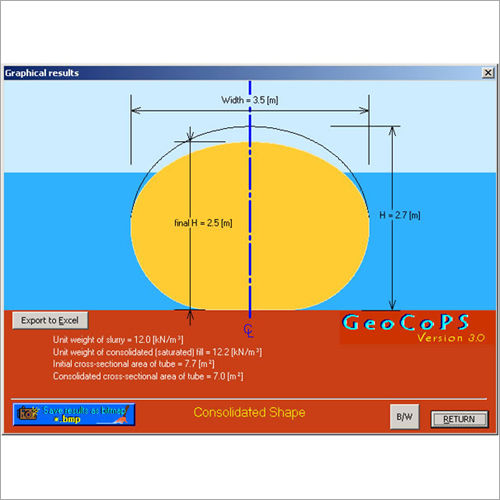FoSSA Software
Product Details:
FoSSA Software Price And Quantity
- 1 Piece
- 50000.00 - 500000.00 INR/Piece
FoSSA Software Trade Information
- 10 Piece Per Week
- 4-12 Week
Product Description
FoSSA (2.0) is an interactive program for assessing stresses and settlements under embankment and footings acting on horizontal ground surfaces.
Within the foundation soil, FoSSA calculates the stress distribution under embankment having complex geometry, the elastic (immediate) settlement, the consolidation settlement (including isochrones: excess porewater pressure and settlement during the consolidation process), accelerated consolidation settlement due to PVDs (triangular and square installation patterns), secondary settlement, and undrained shear strength distribution within consolidating layers.
2-D or 3-D embankments can be input. The embankment needs not be symmetrical nor have horizontal foundation surface. The embankment can be comprised from up to 20 different materials, each having its own geometry. Such an option allows for the description of an embankment comprised from alternating layers of soil and geofoam (or other lightweight fill). Mouse functions or tabulated coordinates can be used to input the geometry; the plot of the geometry is updated as the data is being input. In case of symmetrical embankment with horizontal layers, an option for quick input data is available, taking advantage of the simple geometry.
Note: 3-D embankment is limited in what it can simulate in its longitudinal direction. That is, the ground surface must be horizontal. Furthermore, the soil profile in any longitudinal section cannot change. However, the embankments end may be at a prescribed slope simulating, for example, a bridge abutment. Soil profile, including the embankments in the transverse direction may have variable elevations.
Layers comprimising the embankment (maximum 20) are useful in simulating staged construction.
Foundation stratum can accommodate up to 50 soil layers including layers of consolidating soil. When identifying a consolidating layer, the user needs to select whether it is singly or doubly drained. Boundaries between layers need not be horizontal. Mouse functions or tabulated coordinates can be used to input the foundation layers; the plot of the geometry is updated as the data is being input.
Stresses immediately after load application are either calculated by integrating Boussinesq equation or input by the user (up to 10 stresses along a layer section can be input). The manual option is useful when field data is available (e.g., piezometric data at time zero which enables one to bypass the Boussinesq idealized elastic solution. One can further use the field data to refine the design parameters (e.g., coefficient of consolidation) via calibration.
Elastic (immediate) settlement is calculated by integrating Hookes equation along a desired vertical section.
The 1-D consolidation settlement is calculated by solving Terzaghi differential equation using a finite difference scheme. The boundary conditions (drainage boundaries and initial excess porewater pressure through the consolidating layer) are accounted for in solving the equation. The user can view numerical or graphical results of isochrones (excess porewater pressure at desired time increments) as well as obtain the settlement at each desired time. Multiple layers may consolidate simultaneously, each at its own rate, independent of the other layers.
The user may create a sequence of loading (staged construction). For each consolidating layer, the additional load in the next loading is superimposed on the last porewater pressure to render the new initial conditions. FoSSA keeps a record of loading history which makes it convenient for the designer to refine the design by examining various scenarios.
Triangular or square pattern of PVDs installation can be specified. FoSSA calculates the average degree of consolidation (and hence, consolidation settlement) at prescribed times considering the combined effect of vertical and horizontal drainage. The optimal PVDs layout can quickly be rationally estimated. Also, staged construction with the consolidation accelerating effects of PVDs can be considered. The analysis using PVDs follows the procedure presented in Prefabricated Vertical Drains, Vol. I: Engineering Guidelines, by Rixner, Kraemer, and Smith, Haley & Aldrich, FHWA report FHWA/RD-86/168, September 1986, Contract No. DTFH61-83-C-00101. Basically, this report provides a practical modification of Barrons solution originally developed for vertical sand drains.
As soft foundation layers consolidate, it undrained shear strength increase. Following the model by Ladd (Stability Evaluation During Staged Construction, by Ladd, Journal of Geotechnical Engineering, ASCE, 1991, Vol. 117, No. 4, pp. 540-615), FoSSA calculates the undrained shear strength within each consolidating layer. Since this strength is a function of the effective overburden pressure, the undrained shear strength within a consolidating layer could be less than that at the boundaries during the consolidation process. FoSSA displays this result graphically and numerically.
Secondary (creep) settlement can be calculated at anytime following consolidation.
Staged construction can be simulated to obtain optimal design. The Main Menu facilitate this process.
Computation scheme can be managed from within the input data menu as well as from dropdown menus in the result section of the program.
Results can be presented graphically or numerically.
Content of printed report can be selected by user. Displayed graphical results can be printed or saved as graphic files.
Each dialog in FoSSA has its own extensive Help (accessed by clicking on ? or pressing F1).
Units can be SI or English (English units are the same as Imperial units).
The user can select the color for each layer of soil for improved graphical display.
The user can control the accuracy of the computations (e.g., numerical integration and differentiation) easily, without getting involved with the actual procedures.
Added features after initial release:
- Stresses and settlement under multiple rectangular footings (up to 100) can be calculated using the same theories as those used for the embankment problem. Staged construction is not relevant for the multiple footings problem.
- Rather than phreatic surface, porewater pressure can be input to reflect a field steady state prior to consolidation (e.g., confined aquifer). This is important in assessing effective stresses and subsequent consolidation settlements.
- Over-consolidation pressure (OCR) can be specified at the top and bottom of each clayey layer (rather than at just one point).
- The coefficient of consolidation, Cv, can be specified as a variable with time to reflect its changing value with effective stress progression (if one is lucky to have such data).
- All tabulated results can be printed, saved as a text file, or exported to Excel, all with a click of a button.
- Coefficients equivalent to Cc and Cr can be input so that eo is not specified.
- A single inhomogeneous consolidating layer can now be represented by up to 10 sublayers, each possessing different consolidation parameters. Free draining may or may not be specified at the outer boundaries of top and bottom sublayer. Time rate settlement then is also a function of each sublayer rendering discontinuous isochrones at boundaries between sublayers.

Price:
- 50
- 100
- 200
- 250
- 500
- 1000+







